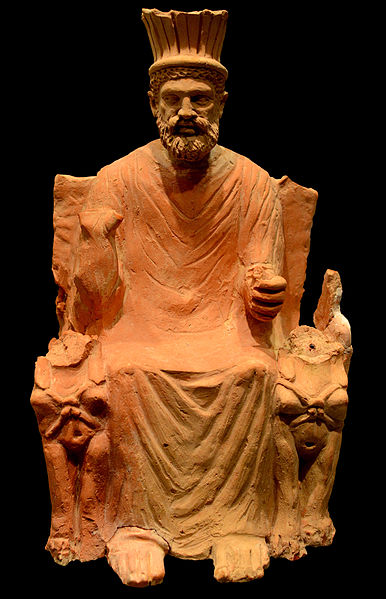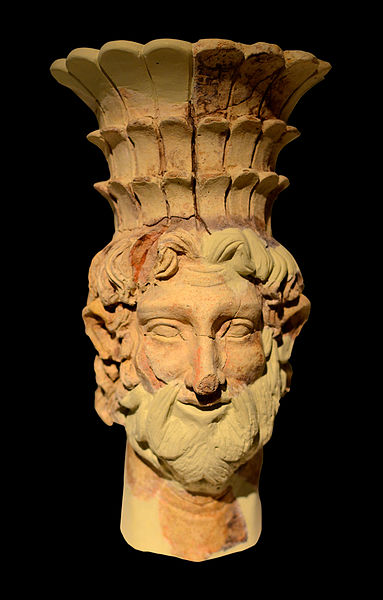BAAL
HAMMON
Ba'al
Hammon Weather and Vegetative Fertility King of the Gods

Statue
of Ba'al Hammon on his throne with a crown and flanked by sphinges,
1st century
Consort
: Tanit
Greek equivalent : Cronus
Roman equivalent : Saturn
Canaanite equivalent : El
Baal
Hammon, properly Ba'al Hammon or English: “Lord Hammon”
Hamon (Phoenician: ba'l Hamun; Punic: b'l hmn), was the chief god
of Carthage. He was a weather god considered responsible for the
fertility of vegetation and esteemed as King of the Gods. He was
depicted as a bearded older man with curling ram's horns. Ba'al
Hammon's female cult partner was Tanit.
Etymology
:
He is clearly identified as one of the Phoenician deities covered
under the name of Baal. However, the meaning of his second name
is unclear. Frank Moore Cross argued for a connection to Hamon,
the Ugaritic name for Mount Amanus, a peak in the Nur Mountains
which separate Syria from Cilicia. In the 19th century, when Ernest
Renan excavated the ruins of Hammon (Hammon), the modern Umm al-‘Awamid
between Tyre and Acre, he found two Phoenician inscriptions dedicated
to El-Hammon. Others have proposed Hammon as a syncretic association
with Libyan-Egyptian god Amun, while a last current has called instead
for a connection with the Northwest Semitic word Hamman ("brazier"),
suggesting the sense "Lord of the Brazier".
Cult
and attributes :
The worship of Ba'al Hammon flourished in the Phoenician colony
of Carthage. His supremacy among the Carthaginian gods is believed
to date to the fifth century BC, after relations between Carthage
and Tyre were broken off at the time of the Battle of Himera (480
BC). Baal Hammon was known as the Chief of the pantheon of Carthage
and the deity that made vegetation grow; as with most deities of
Carthage, he was seemingly propitiated with child sacrifice, likely
in times of strife or crisis, or only by elites, perhaps for the
good of the whole community. This practice was recorded by Greeks
and Romans, but dismissed as propaganda by modern scholars, until
archeologists unearthed urns containing the cremated remains of
infants in places of ritual sacrifice. Some scholars believe this
confirms the accounts of child sacrifice, while others insist these
are the remains of children who died young. [dubious – discuss]
He
has been identified with a solar deity, although Yigael Yadin thought
him to be a moon god. Edward Lipinski identifies him with the god
Dagon. In Carthage and North Africa Ba'al Hammon was especially
associated with the ram and was worshiped also as Ba'al Qarnaim
("Lord of Two Horns") in an open-air sanctuary at Jebel
Boukornine ("the two-horned hill") across the bay from
Carthage, in Tunisia.
The
interpretatio graeca identified him with the Titan Cronus. In
ancient Rome, he was identified with Saturn, and the cultural
exchange between Rome and Carthage as a result of the Second Punic
War may have influenced the development of the festival of Saturnalia.
[clarification needed]. Attributes of his Romanized form as an
African Saturn indicate that Hammon (Amunus in Philo's work) was
a fertility god.

An
incense burner depicting Ba'al-Hamon, 2nd century BC
Location
:
Ba'al Hamon was a place mentioned in the Song of Solomon. It was
the location of a productive vineyard owned by Solomon, who let
out the vineyard to tenants, each of whom was to bring him a thousand
silver shekels. The locale has been supposed to be identical with
Baal-gad, and also with Hammon in the tribe of Asher.
Source
:
https://en.wikipedia.org/
wiki/Baal_Hammon


